Какое оборудование ставить на эмиль 2 в world of tanks

Click here for more information.
Magazine-fed Gun
Click here for more information.
Magazine-fed Gun
Using Shell Type 1 (360 Damage):
Click here for more information.
Magazine-fed Gun
Using Shell Type 2 (360 Damage):
Click here for more information.
Magazine-fed Gun
Using Shell Type 3 (460 Damage):
With wholly penetrating hits
Click here for more information.
Magazine-fed Gun
Using Shell Type 1 (440 Damage):
Click here for more information.
Magazine-fed Gun
Using Shell Type 2 (440 Damage):
Click here for more information.
Magazine-fed Gun
Using Shell Type 3 (530 Damage):
With wholly penetrating hits
Click here for more information.
For more details, see Crew
For more details, see Crew
For more details, see Crew or Equipment
For more details, see Crew or Equipment
For more details, see Skills or Equipment
For more details, see Skills or Equipment
For more details, see Skills or Equipment
For more details, see Skills or Equipment
Values are Stock - click for Top Values are Top - click for StockThe Emil II is a Swedish tier 9 heavy tank.
A variant of the heavy tank developed under the project of 1949. In 1952, three heavy tank projects were proposed. The EMIL 1952 E2 was the second variant. Depending on the armor and mounted engine, the weight of the vehicle varied from 34 to 39 tons. However, at the end of 1952, development of the E2 version was discontinued in favor of the E3 version, which had similar characteristics but improved armor.
The Emil II leads to the Kranvagn.
Пять вещей, которые не стоит делать на Emil 1951
- Стрелять по «светлякам». Долгое сведение и низкая скорость полёта снаряда дают небольшую вероятность попадания.
- Держать направление в одиночку. Барабан кончается быстро, а маленькое количество единиц прочности не позволяет держаться под огнём.
- Подставляться под огонь САУ. Танк впитывает урон от фугасов. Если у противника много артиллерии, старайтесь искать непростреливаемые места.
- Воевать в одиночку без поддержки союзных ЛТ или СТ. У танка не самый широкий обзор — всего 360 метров.
- Перестреливаться в лоб с танками IX уровня. Бронепробития подкалиберным снарядом 242 мм достаточно для уверенного поражения тяжей IX уровня только в уязвимые зоны.
Modules / Available Equipment and Consumables
Историческая справка Шведского Emil II
Танк модели EMIL II – это разновидность предыдущей модели Emil 1, однако он более тяжелый и габаритный, вес его составляет от 34 до 39 тонн, что конечно зависит от бронирования и массы двигателя. Что касается самих двигателей для данной модели, то здесь предлагалось два варианта – это 540-й или 665-й.
Это более модернизированная, более востребованная по своему потенциалу модель танка Emil, в производстве которой применялся шведский двигатель, однако, когда производство поставило на поток еще более мощные двигатели, то Emil 2 также отошел на второй план, как и его предшественник Emil 1, а в 1952 году и вовсе был снята с конвейера.
Тут же была представлена следующая модель – это Emil 3, но здесь дела обстояли несколько непонятно: самый мощный танк с массой до 42 тонн был просто нереалистичен, так как для такого не находилось наиболее подходящего двигателя шведского производства.
Все изменилось, когда стали доступны моторы американского производства. Таким образом, создавая третью модель, было кое-что от Emil 2 – это пушка в 150 мм, имеющая гладкоствольный корпус. Тут же было добавлено бронирование по бортовым сторонам и спереди, таким образом, Emil 2 и Emil 1 были полностью вытеснены, а третья модель была принята за основную.
Что за пистолет-пулемёт в корзинке?
На башне Emil 1951 с тыльной стороны крепится брезентовая палатка, а по бокам находятся стальные сетчатые клети с боеприпасами. В них размещается всё самое необходимое: консервы, топливо — настоящий набор для пикника, если бы не пистолет-пулемёт, лежащий рядом с канистрой.


Кстати, оружие историческое: это пистолет-пулемёт М/45, разработанный шведской государственной оружейной компанией «Карл Густав». Он был принят на вооружение в 1945 году и предназначался для замены ранее выпускавшегося по лицензии финского пистолета-пулемёта «Суоми». Интересный факт: это оружие использовали бойцы элитного американского спецподразделения SEAL.
Краткий итог по танку Emil II
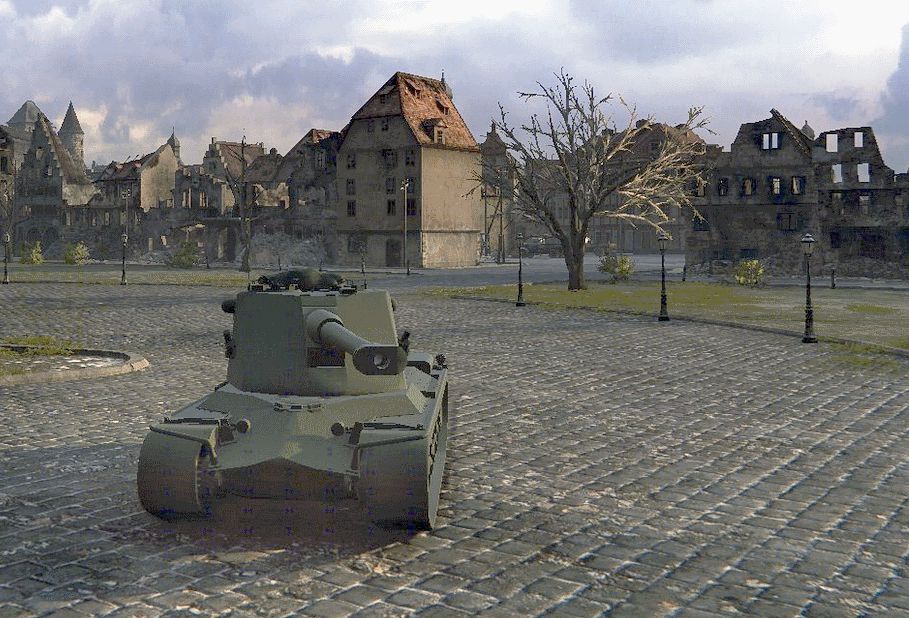
Внешний вид Emil II шведского тяжёлого танка 9 уровня WoT очень похож на французский тяжёлый танк AMX 50 120, из плюсов можно заметить, что склонение орудие у шведа весьма годное для игры из-за укрытия, а вот пробитие и само орудие имеет худшие характеристики. Чего стоит только перезарядка внутри барабанной системы заряжания равной 5 секундам, а общее заряжание барабана более 38 секунд.
Что получаем в итоге: посредственное бронирования тяжелого танка Швеции, где имеется барабанная система заряжания на EMIL II, что привлечет многих игроков и при отличные УВН.
Порой в боях можно встретить интересную и редкую машину Emil 1951. Однако ни в ветке прокачки шведских танков, ни в Премиум магазине вы её не найдёте. Как её получить? Есть только один способ — играть в «Линии фронта». Но, чтобы машина оказалась в Ангаре, придётся приложить серьёзные усилия. Так что можно с уверенностью сказать, что обладатель этого танка — опытный игрок и опасный противник.
Emil 1951 похож на обычную шведскую «восьмёрку», но прибыльнее в боях, поскольку это премиум танк. А теперь рассмотрим его подробнее.

Modules
Engines
Suspensions
Radios
Compatible Equipment
Compatible Consumables
Player Opinion
Pros and Cons
- Virtually impenetrable frontal turret armor with extremely small weakspots
- Great burst damage on top gun with acceptable penetration
- Decent mobility for a heavy
- 12 degrees of gun depression - better than any other tier 9 tank, can use hull-down positions very effectively
- Surprisingly good base view range; with good equipment and skills it can effectively spot on its own
- Relatively easy stock grind, as its stock gun has decent penetration and good burst damage, and also doesn't have additional turret to research
- Fast reload with top cannon (25 seconds) for 3 clip autoloader of 440 damage a shot, above average for a 12cm cannon, for around 2,555 damage per minute, a substantial buff from update 1.5
- Weak hull armor overall, with very poor side and rear armor
- Subpar penetration on HEAT round (300mm), unable to deal with superheavies reliably
- Tied with FV4005 for the worst gun elevation in the game (8 degrees), shooting an enemy at high places and when the tank is downhill is very difficult
- Long aiming time (2.6 seconds) with subpar accuracy (0.36 dispersion)
Performance
Emil II is very similar to its predecessor in terms of play style. The most notable difference is massively improved gun and even better turret armor, while it still maintains the 12 degrees of gun depression. It is best used at mid-range combat in hull-down positions where the hull is protected and the turret is the only part exposed. The turret is one of the strongest in the tier, and can easily bounce all standard and most premium shells. However, premium ammo from tier X destroyers and high calibre HE shells can and will get through, so beware.
Hull armor is very weak and unreliable. The player must be aware of the hull exposure while being focused at anytime to maximize survival. Weak hull also makes this tank bad for brawling - after you empty your clip, you are basically dead, as everyone will pen you from any angle in the hull. The tank's mobility is average, but it is still mobile enough to get around and re-position wherever needed.
Emil II should be played as a support or on ridges, preferably with other tanks nearby. Fighting alone can lead to quick death as soon as enemies realize that you are reloading, so be cautious. Also be aware of artillery as they will punish you if you stay in focus for too long.
Early Research
The cannon is the main priority, as it is just better than the stock cannon. After that, any order of research is fine, but most important (after the top cannon is researched) is engine and tracks to improve mobility.
Suggested Equipment
External Reviews and Opinions
Gallery


Historical Info
In 1952, the development of the next Swedish tank was well underway – despite the fact the work started as early as in 1951, it was only now when it really picked up the pace. In 1952, the project was reworked from a set of basic requirements and schematics into a functional design. More outlandish ideas were scrapped in favor of technologies, that had already been prototyped or tested and several new ideas were being tested as well. As an example, the suspension was changed to a hydraulic one, based on the Lvkv 42 prototype self-propelled anti-aircraft gun and work started on a prototype gun on the basis of the old 15cm Haub m/39 howitzer.
The EMIL project started out in 1951 as more of a medium tank, but in 1952, the army, like other western nations, decided that they needed something to counter the Soviet IS-3 heavy tank and it was this line of thought, that would above all else shape the EMIL project after 1951.
The main inspiration for the design seems to have been drawn, initially at least, from the French and German tank designs – more specifically from the new AMX 13, which had recently been tested in Sweden, as well as the German Panther. The influence of these tanks can be seen in the addition of a French style oscillating turret with an autoloader and the well-sloped frontal glacis. But in 1952, as the design was being reworked, it was decided to borrow the Soviet idea of the pike nose in order to increase the effective thickness even further.
Although all were based around the same principles, there were several different variants of the EMIL, specificially there were three main ones. First was the E1, which was to correspond with the 1951 proposal, but with the new pike nose front and with an American tank engine instead of a Swedish one. The second design was called E2 and was a sort of a middle range model, which would be heavier than the E1, but also would be able to carry a 15cm smoothbore instead of the 12cm rifled gun, planned for the earlier models. The E2 was also able to sport a bigger engine and this design was considered as the most realistic one, since there was no guarantee that a bigger engine could be acquired. Last was the E3, which was the top range model with a weight of over 40 tons and an American 810hp engine, this was at the time seen as a bit too heavy and unrealistic, but as the engine became available, this design was chosen and two hulls were built in 1955.
A chart with various models
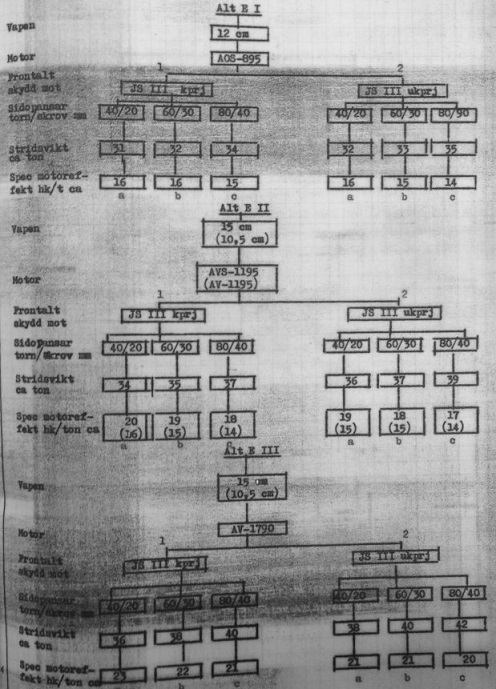
Some of the other variables that separated the designs included front and side armor for the hull and turret, engine output, main armament and suspension. In the case of frontal armor, there was a choice of either having a 120mm hull and 140mm turret armor or 145mm hull and 170mm turret armor, these thicknesses were specifically chosen to be able to withstand a frontal hit from the IS-3 heavy tank with either (in the first case) regular AP ammo or (in the latter) subcaliber ammo. Side armor was divided into 3 options: first was a 20mm hull and 40mm turret, 2nd was a 30mm hull and 60mm turret and third was a 40mm hull and 80mm turret. The rest of the armor was common to all variants of the tank. This included the hull roof, driver’s port (middle front glacis) and floor. The rear armor was 30mm for all the variants except for the one with 40mm side armor, where the rear was also 40mm thick.
One of the most important variables was the engine output. As mentioned before, the engines considered were American tank engines, mainly from Continental. These included the AOS-195 (500hp), AV-1195 (540hp), AVS-1195 (665-668hp) and AV-1790 (810hp) models. Initially, it was thought that the acquisition of the more powerful engines wouldn’t be possible and therefore initial projections favored a middle range tank model in both weight and armor, but as negotiations continued, an example of the 810hp was acquired and considered for licensed production at SFA (the Swedish aircraft engine company). This meant that there were no longer any problems with the engine output for the tank and that the development of the top range model could be pursued. However, as the development of the tank continued, it was decided to use a Swedish engine instead, as one of sufficient power had been developed at SFA. The new engine was very powerful at around 900hp, but the power required to run the cooling system meant that when it was finally tested on the prototypes in 1955, it could only deliver 723hp with the rest being used up by the cooling system itself.
Even before 1951, studies had been made regarding the armament of what would become the EMIL project. These studies had concluded that the best armament for a future tank project would be a high caliber gun (12cm or higher) in order to effectively use HEAT shells. But these were no regular HEAT shells – in fact the Swedish idea was to mix the properties of APDS and HEAT to create a heat shell with a discarding sabot. This would allow the shell to travel much faster than a normal HEAT shell. Ultimately, the development of these munitions would prove impossible for Sweden and would be a major reason behind the cancellation of the project. The actual gun considered to use this kind of shell was at first a 12cm L/40 rifled gun and later a 15cm L/40 smoothbore gun. Besides the HEAT shells, these guns were to fire mainly HE, although there were plans for APDS ammunition as well. There were also plans for a 10,5cm gun in case the development of the previously mentioned guns would prove too complicated. One thing of note is that the 150mm gun is not viable for World of Tanks, as it is a smoothbore.
Drawing comparing the different gun options
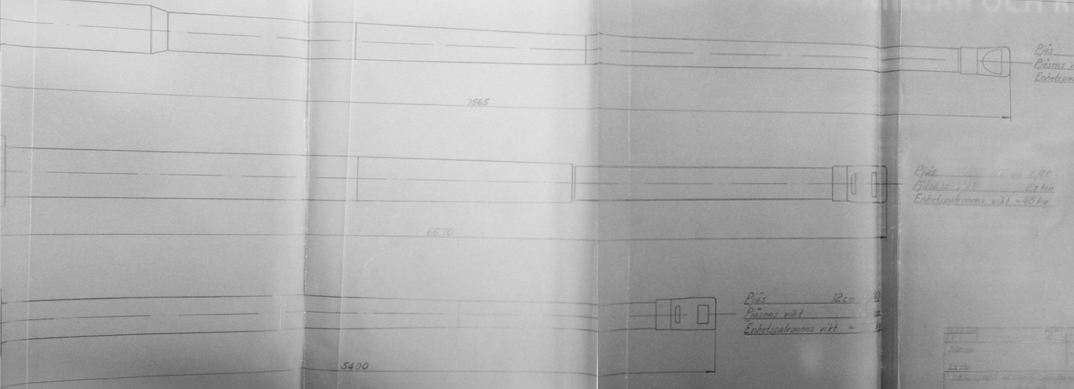
Suspension was another thing that varied quite a bit between the different designs. We know that there were plans for up to 8 roadwheels per side, but the final prototypes ended up with 6 per side.
I should state however that some changes were made to the EMIL project after the completion of the prototypes in 1955. The main change was to the turret armor which was changed from the planned 170/80/40 to 170/70/30 in order to stabilize the gun better, elevation also changed from +8/-12 to +10/-12. Other than that, there were plans to potentially mount a British or French gun on the vehicle in 1958 after the development of a suitable Swedish one had failed.
So to summarize, the Emil was to be a heavily armored but mobile tank with a weight of under 50 tons and a 10,5-15cm gun, capable of dealing with the IS-3 at long range. So you might be thinking, why was it that this tank never entered production? Well, initially the idea was that this tank would replace the WW2 vintage Strv m/42, but the gap between the two tanks would mean that Sweden would be without a modern tank during most of the 1950′s, until a production version of the EMIL was ready. What happened instead was that Sweden purchased the British Centurion tank as a stopgap measure and with the development of the L7 gun in the late 50′, there was no longer a need for the EMIL project. However, some work continued on the prototype chassis which had been named “Kranvagn” (crane vehicle) to confuse any potential spy.
Akv 151 prototype SPG
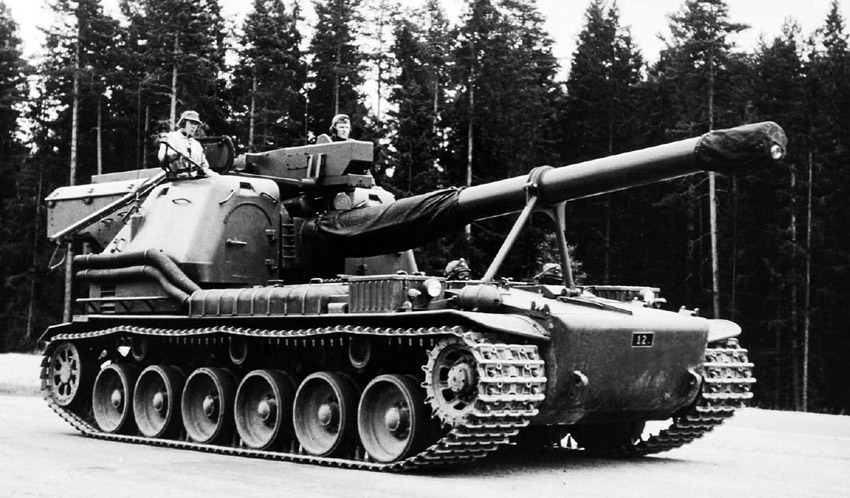
Work on a new 15cm autoloading SPG had been in progress since before the EMIL project and a version based on the EMIL hull had been in the work since the start of the project. After the initial testing in 1955-1956, it was decided that one of the prototype hulls would be converted to this SPG configuration. This vehicle prototype was built in 1960 and would eventually become the Bkan 1, but that is a story for another time
There was also an idea to mount the Centurion Mk.10 turret on the Krv chassis in order to create a competitor to the Centurion Mk.10, but in the end, the Swedish army decided that it would be simpler if they just purchased the whole Centurion Mk.10 instead. However there were also plans to let a vehicle in this configuration serve as a prototype for future turreted tank concepts in Sweden, but nothing ever came of this. Instead, the remaining prototype had 4 of its roadwheels removed and was fitted with equipment for testing of the hydraulic suspension as well as a fixed 20pdr gun and was used as a test rig for the S-tank. This prototype chassis still exist in the Arsenalen museum, although it’s currently in storage and not on display.
Interpretation of the Centurion/Kranvagn hybrid

Kranvagn chassis during suspension testing for the S tank project
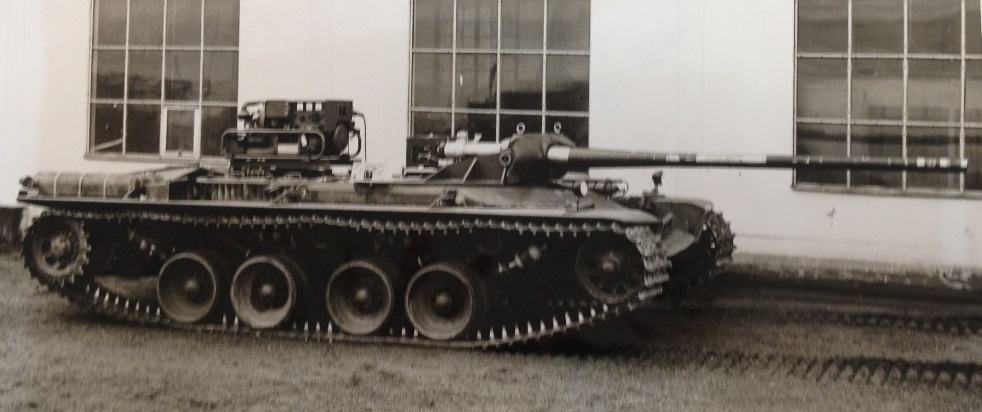
Last time the Krv chassis was seen by the public was its move to the new Arsenalen museeum storage
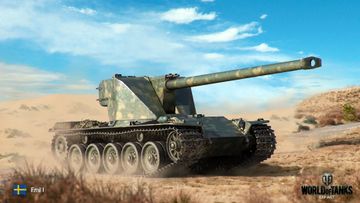
Тяжёлый танк Emil I исследуется на Leo за 95 400 .
16300
33400
42000
165000
16700
44000
9400
57200
| Итог: | |
| Кредиты: | 299600 |
| Опыт: | 84400 |
Боевая эффективность
- отличные УВН вниз;
- крепкое лобовое бронирование башни;
- неплохое бронепробитие топового орудия;
- неплохая динамика.
- слабая броня корпуса;
- долгая реализация барабана;
- низкий запас прочности;
- долгое сведение;
- перегруженность командира;
- невысокий обзор.
Экипаж
- Боевое братство улучшит характеристики танка.
- Ремонт ускорит починку поврежденных модулей.
- Комбинация Орлиный глаз + Радиоперехват даст прибавку к обзору в 5%.
- Комбинация Плавный поворот башни + Плавный ход позволит меньше терять времени на сведение при движении и повороте башни.
- Шестое чувство поможет определить, обнаружен ли танк или нет.
- Снайпер повысит убойную силу пушки.
- Король бездорожья улучшит подвижность по слабым грунтам.
- Отчаянный повысит ДПМ в жарких схватках.
- Виртуоз немного улучшит маневренность.
Оборудование, снаряжение и боекомплект
- Улучшенная вентиляция даст небольшой бонус к характеристикам танка.
- Стабилизатор вертикальной наводки позволит точнее стрелять на ходу.
- Просветленная оптика даст прибавку к обзору как стоя, так и в движении.
Стандартный набор снаряжения — ремкомплект, аптечка и огнетушитель.
Основные снаряды - подкалиберные. Специальные подкалиберные стоит заряжать для встреч с бронированными противниками. Осколочно-фугасные снаряды пригодятся для сбития захвата базы.
Emil II Шведский тяжёлый танк 9 уровня World of Tanks успешно начал путь тестирования на СуперТесте. Тактико-технические характеристики не окончательные, а носят только предварительный характер.

Фармит и тащит
Так как это полноценный премиум танк VIII уровня, результативный бой может подарить много опыта и серебра. Emil 1951 принесёт доход, даже если придётся выпустить парочку барабанов подкалиберных снарядов в противника.
Emil 1951 оборудован барабаном заряжания на три снаряда, каждый из которых способен нанести 360 единиц урона. То есть около 1000 единиц урона при меткой стрельбе даже в случае безвременной смерти в первые минуты боя обеспечены.

Перезарядка внутри барабана — 2,7 секунды, что немного быстрее, чем у Emil I. А ещё у машины прочная башня и отличные УВН, намекающие на то, что надо играть от рельефа. Особенно комфортно это делать на таких картах, как «Малиновка», «Ласвилль», «Вестфилд» и «Мурованка».
Лобовая броня башни толщиной 180 мм под рациональным углом способна на многое. Например, неплохо отбивает бронебойные снаряды от многих танков выше уровнем.
Основные преимущества Emil 1951
В топе этот танк превращается в грозного противника: зачастую с барабана может забрать противника или серьёзно его покалечить. А пробить в лоб ему удастся практически любого тяжа VIII уровня.

У Emil 1951 хорошая динамика для тяжёлого танка. Он быстро разгоняется до 30 км/ч и без труда набирает максимальные 45 км/ч. Машина входит в топ-5 самых быстрых премиум тяжей VIII уровня.
У танка крепкая башня, которую сложно пробить «одноклассникам», а машинам ниже уровня и подавно. Так что Emil 1951 идеально подходит для игры от рельефа. А УВН помогут комфортно использовать крепкую башню, не подставляя уязвимые зоны.
Умения экипажа Emil II
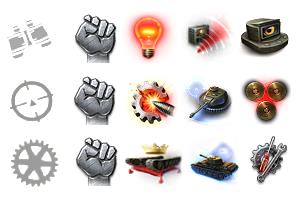
Для того, чтобы вести бой с большей эффективностью, необходимо будет поработать над таким умением, как «шестое чувство», благодаря которому появится возможность заранее предугадывать момент, кода противник осуществляет прицеливание. Данное обязательство должно возлагаться на командира экипажа как на лидера в своей команде. Что касается остальных членов команды, то им требуется прокачка такого умения, как «боевое братство», благодаря чему будут улучшены все характеристики боевой машины. Иногда можно попробовать использовать и маскировку, но тут следует помнить, что с тяжелыми танками такой прием не сработает, так как такие боевые машины не имеют нужных коэффициентов для данного свойства.
Умение «снайпер» особенно важна для такой модели танка как Emil 1, благодаря этому может быть нанесен критический урон противнику. Умения «плавный ход» и «плавный поворот башни» также очень важны для экипажа, так как их сочетание значительно повышает навык стрельбы на ходу. Также стоит обратить внимание на умение «король бездорожья», благодаря чему повысится маневренность машины, а вот таран в данном случае окажется совершенно бесполезным. Для улучшения обзора стоит устанавливать «орлиный глаз» и «радиоперехват». «Бесконтактная боеукладка» также не окажется лишней.
Исследование Emil II
Как не странно, но для установки трёх дополнительных модулей в Emil II даже не потребуется исследовать и установить ходовую часть, а поэтому лучше всего поступить следующим образом:
1) установить три дополнительных модуля на танк описанные в подзаголовке ниж;
2) орудие 12 cm akan L/40 за 62 600 опыта (рекомендуем потратить накопленный свободный опыт);
3) двигатель AVS-1195 за 24 700 опыта (с увеличенной мощностью на 115 л.с.);
5) ходовая Emil II 1 b за 24 500 опыта, нужна ли ходовая на танк весьма сомнительно, ведь общая грузоподъемность танка позволяет установить все необходимые модули, а тратить 24 000 опыта для увеличения скорости поворота, не совсем рентабельно.
Тактико-технические характеристики Emil II
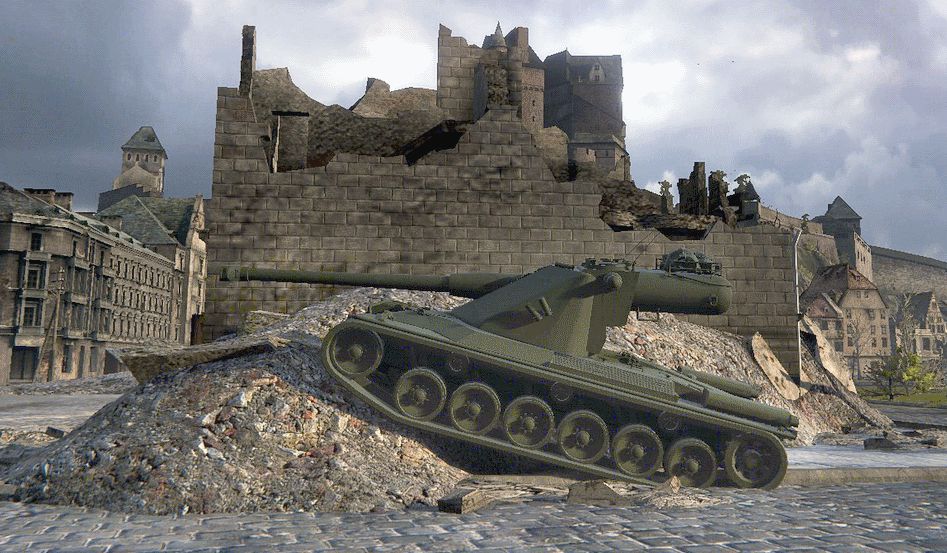
На тестирование шведский Emil II отправляется со следующими характеристиками:
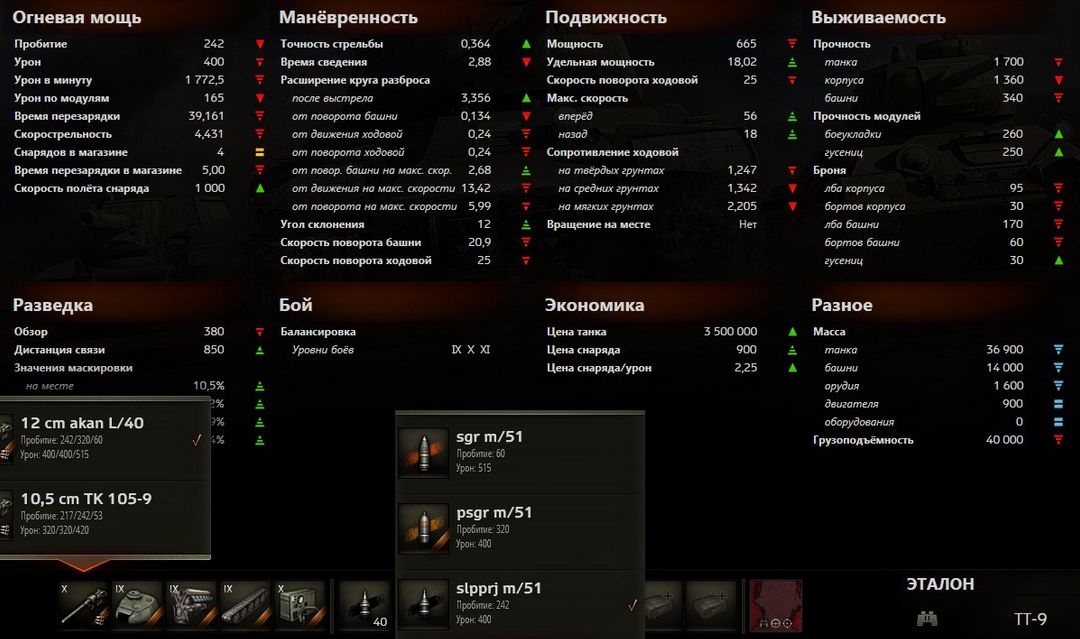
Как играть?
Здесь всё зависит от карты и уровня боёв. Например, на «Малиновке» в сражении с «одноклассниками» хороший вариант — играть от башни на горе. Углы склонения орудия позволяют не подставлять уязвимый корпус. А выцелить командирскую башенку не все противники способны: она небольших размеров.

Тот же принцип игры и на «Вестфилде»: здесь можно не боясь перестреливаться с противниками, умело используя рельеф и нанося значительный урон.
Если карта не позволяет полноценно играть от рельефа, тактика следующая: ждать, пока противник выстрелит, затем ставить его на каток, разряжать барабан и уходить на перезарядку за спины союзникам.
В боях с танками IX–X уровней стараемся держаться на 2-й линии и пробуем найти момент, когда барабан будет наиболее полезен и нам с точки зрения нанесения урона, и союзникам, которым мы можем помочь, продержав противника на катке какое-то время.
Зачем нужны баллоны на корпусе?
При ближайшем рассмотрении на корпусе танка можно заметить несколько баллонов. Что в них хранится? Почему они расположены на корпусе в открытую? Ведь они так уязвимы для огня противника.
На самом деле всё просто: это баллоны со сжатым воздухом, которые применялись для запуска двигателя. Почему они ничем не защищены? В металле Emil 1951 не существовало — были построены только несколько шасси, одно из которых стало базовым для самоходной артиллерийской установки Artillerikanonvagn 151. Если посмотреть на снимки самой САУ, можно заметить идентичный баллон на корпусе. Современные САУ, как правило, действуют со значительного расстояния и быстро меняют позицию, поэтому повреждение такого баллона маловероятно, а возможность быстро завести двигатель в бою бесценна.


Оборудование для Шведского Emil II
Читайте также:


